Hi-res music streaming services compared: is Tidal, Qobuz, Amazon or Apple Music better?
Tidal, Qobuz, Amazon Music and Apple Music all offer hi-res, but which deserves your monthly fee?
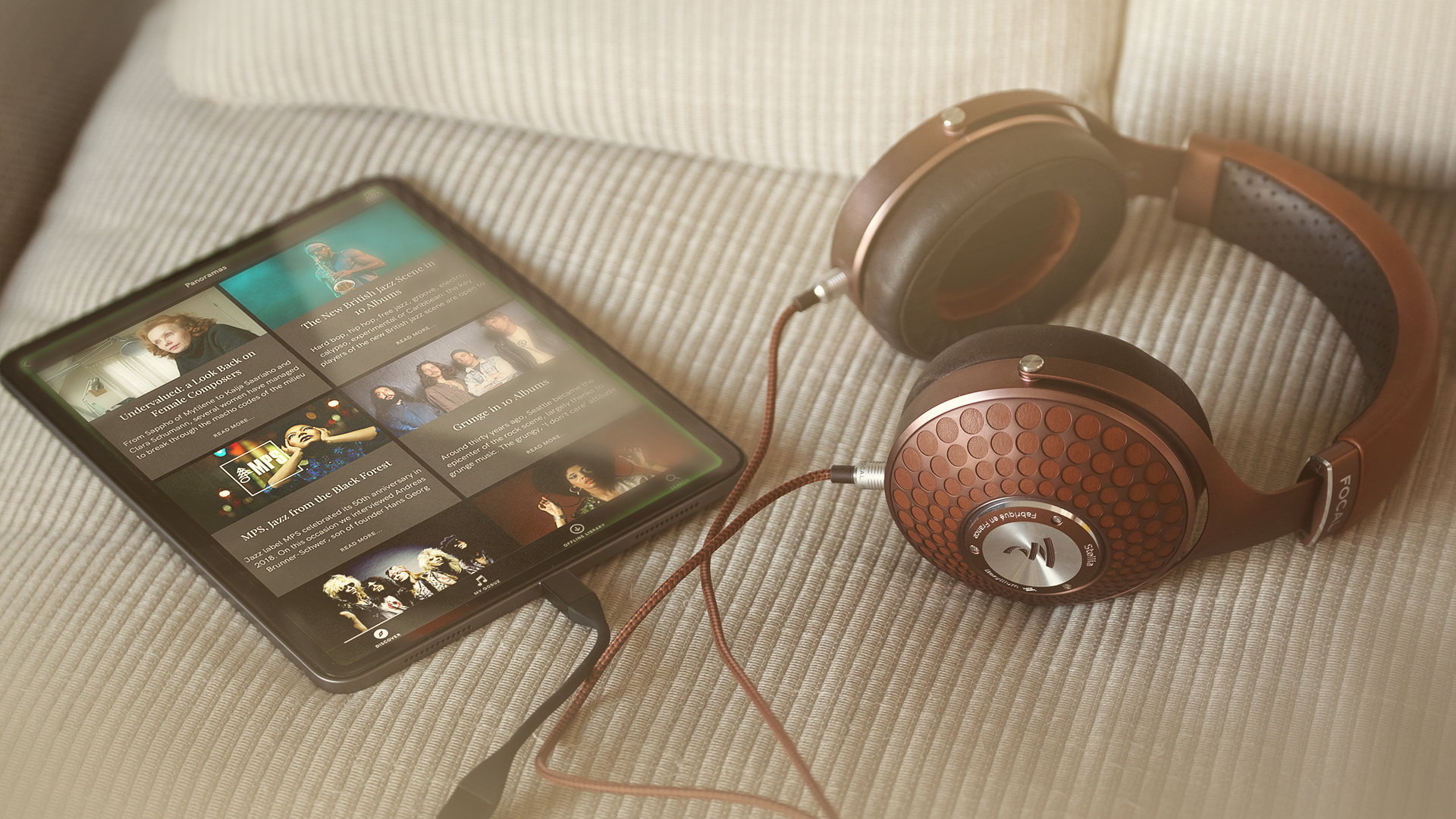
The battle to become the best music streaming service for offering hi-res streams is well and truly underway. Gone are the days when all a streaming platform had to do was offer up low-quality Ogg Vorbis or MP3 streams and make you endure a few ads for the privilege. Today, the key to victory is ad-free, hardware-supported streaming in high-resolution audio quality – and, crucially, for the best price.
Qobuz was actually the first player in the hi-res streaming game (except in Australia, where it only launched in 2021) and is still kicking about with an excellent-sounding offering that has significantly reduced in price in recent years to remain competitive in the face of other services adopting hi-res. As well as a streaming-only tier, it uniquely offers a subscription that in addition to streaming also offers 60 per cent discounts on hi-res downloads from its online store.
Then there's Tidal, which became the first proper hi-res streaming rival to Qobuz and helped carve out an ecosystem of MQA-supporting products through its decision to use that audio technology to power its hi-res 'Tidal Master' streams. Currently our favourite streaming service for hi-fi fans, Tidal has recently replaced the licensed MQA format with the open-source FLAC, and simplified and cheapened its offering (hi-res, CD-quality and Dolby Atmos Music) to compete with Apple and Amazon.
Which brings us to hi-res streaming's biggest game-changing moment yet. In 2021, Apple announced that its Music streaming service would offer CD-quality, hi-res and spatial audio streams to subscribers... for no extra cost. That would've undoubtedly been a big blow to Tidal and Qobuz, not to mention Amazon Music, which by that point had also launched a hi-res tier. Amazon's immediate response? To bundle its hi-res streams into its standard subscription as well. Tidal and Qobuz were then forced to follow suit in lowering their prices too.
So things are certainly more on an even footing for those four services, while Deezer (which has CD-quality only streaming) and Spotify (the delay of its Spotify HiFi tier leaves the world's most popular streaming service with the poorest-sounding streams) bring up the rear with inferior offerings.
But there are still notable differences between the hi-res music services when it comes to hardware support, user experience and features, so the question of which service best deserves your monthly subscription is a valid one.
Below, we try to help you decide just that, starting with the differences between lossless and hi-res music, and offering a breakdown of the services and their USPs. Get ready: your music is about to sound a lot better.
| Service | Free tier | Monthly hi-res price | Supported formats | Max streaming quality |
| Spotify | Ad-supported, 128kbp | - | OGG | 320kbps |
| Apple Music | - | £11 / $11 / AU$13 | AAC, ALAC | 24-bit/192kHz |
| Tidal | - | £11 / $11 / AU$13 | AAC, ALAC, FLAC | 24-bit/192kHz |
| Deezer | Ad-supported, 128kbps | - | FLAC | 16-bit/44.1kHz |
| Amazon Music Unlimited | - | £11 / $11 / AU$13 (or £10 / $10 for Prime Members) | FLAC | 24-bit/192kHz |
| Qobuz | - | £13 / $13 / AU$20 | AIFF, ALAC, FLAC, WAV, WMA Lossless | 24-bit/192kHz |
| YouTube Music | Ad-supported, 126kbps | - | AAC | 256kbps |
What is hi-res streaming and why should you want it?
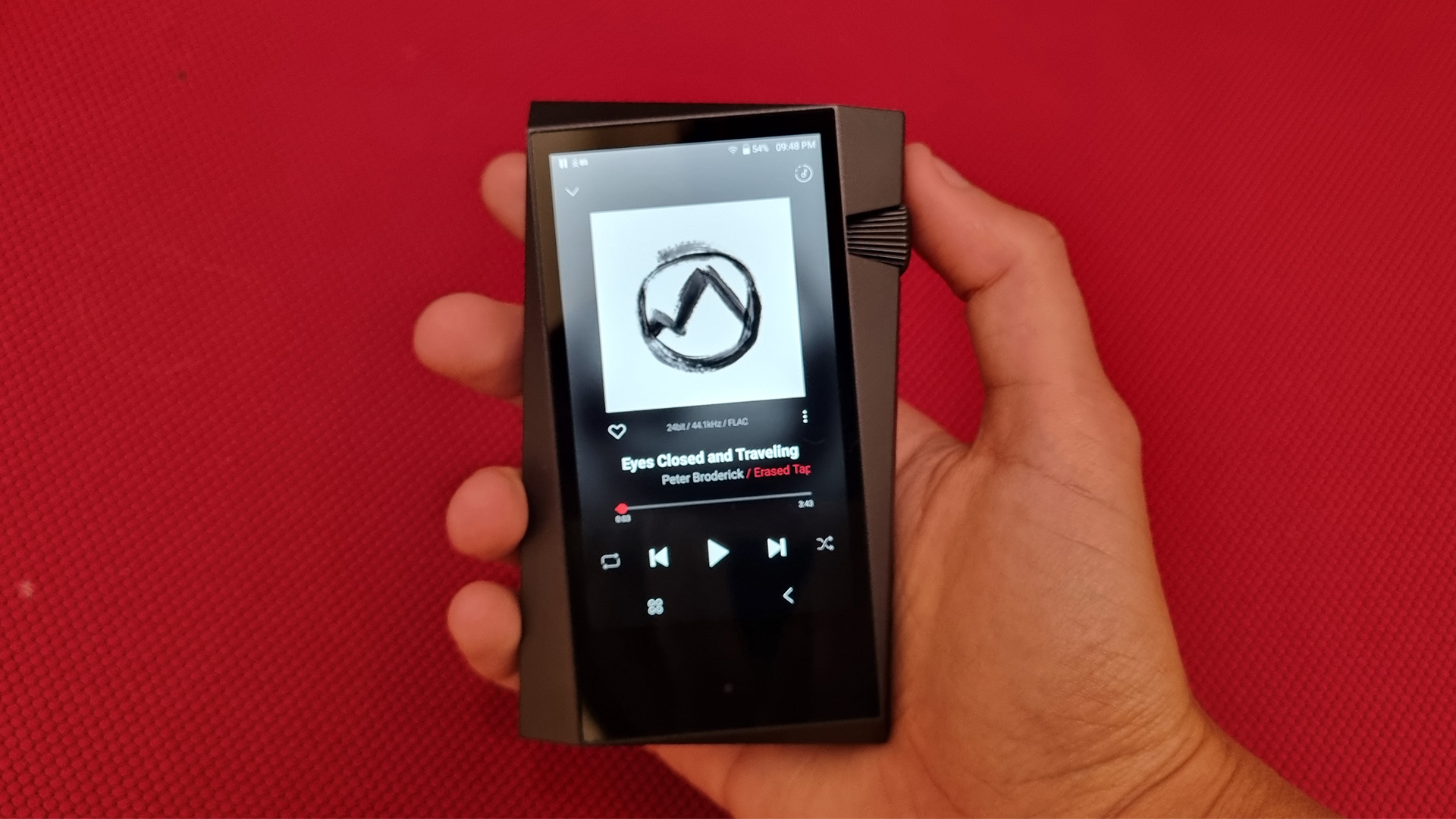
First things first, should you care about hi-res streaming? High-resolution (often shortened to 'hi-res') audio is a term used to describe music files that have a higher sampling frequency and/or bit depth than that of CD quality, which is specified at 16-bit/44.1kHz. So a hi-res file can be 24-bit/44.1kHz, where bit-depth is higher than CD quality but the sampling rate is the same, and vice versa.
So what do the numbers mean? It might help to think of an audio signal as a sound wave being plotted on a graph. Sampling rate – the second number – refers to the number of times per second that the wave is measured during the analogue-to-digital conversion process. The higher the sampling rate, the more times the audio signal has been sampled, and thus the more detail resolution you get.
The first number is bit-depth, which indicates the number of 'bits' of information present in each sample of the signal. Going from 16 to 24 bits results in a massive increase in dynamic range, which is the gap between the quietest and loudest sounds that can be captured. In numbers, it's a jump from 96dB to 144dB, which is huge.
Until Spotify Hi-Fi arrives, all streams from Spotify use compressed file formats with relatively low bitrates, such as 320kbps Ogg Vorbis streams on Spotify Premium. This 'lossy' compression means that certain data is scrapped in the encoding process for the sake of convenience and smaller file sizes. Obviously, this affects the sound quality.
To illustrate why hi-res should sound better than, say, an MP3, we need simply to compare the relative bitrates (the amount of information being transferred measured in kilobits per second). The highest quality MP3 has a bitrate of 320kbps. A 24-bit/192kHz file takes that to 9216kbps. Music CDs are 1411kbps – remember, they're your starting marker for hi-res.
The hi-res 24-bit/96kHz or 24-bit/192kHz files should, therefore, more closely replicate the sound quality the musicians and engineers were working with in the studio. Provided your system is transparent enough, playing hi-res music can bring you more detail and texture, thus bringing you closer to what the artist wanted to say when they recorded their work. And isn't that what we want?
Although hi-res audio songs and albums have been available to download for several years now, streaming hi-res audio is relatively new across popular music subscription platforms – and some still don't offer it.
For more information, read our high-resolution audio explainer.
Hi-res vs 'lossless': what's the difference?
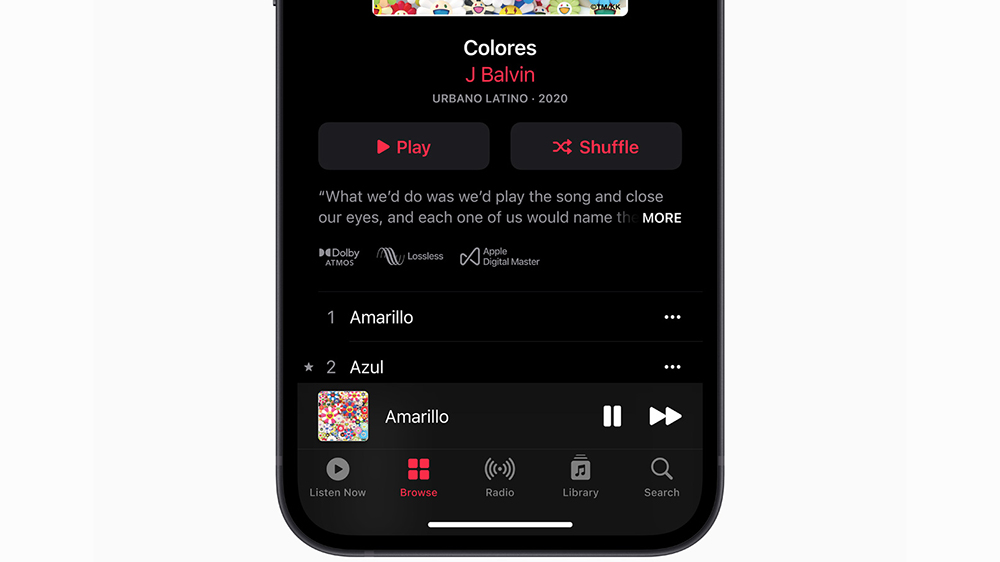
While the terms 'lossless' and 'hi-res' may be used in close connection – Apple Music uses 'Lossless' and 'Hi-Res Lossless' labels while, to complicate matters further, Amazon Music prefers the terms 'HD' and 'UHD' when referring to its more premium audio offerings – music that is lossless is not always hi-res.
Where hi-res audio is generally understood as music with a resolution higher than CD quality, lossless audio has no set specification in terms of bitrate. The term covers only how much data has been thrown out during the encoding process and, as a result, how much quality or “loss” you will experience when you play it.
If no compression algorithm (or codec) has been used to compress the audio within your particular file, two things happen: lossless (though not necessarily hi-res) sound quality and, due to the large file size of audio that hasn't been compressed, a storage warning on your device!
That said, the term lossless audio is commonly used to describe CD-quality music, which is specified at 16-bit/44.1kHz.
- MP3, AAC, WAV, FLAC: all the audio file formats explained
- What are the best Bluetooth codecs? aptX, AAC, LDAC and more compared
Which streaming services offer hi-res music?
Short answer: Tidal, Qobuz, Amazon Music and Apple Music.
Here's an explainer on each service, the tech they use to deliver hi-res, what you'll need to play it, and, crucially, for whom each service will likely be best suited.
Tidal – for audiophiles
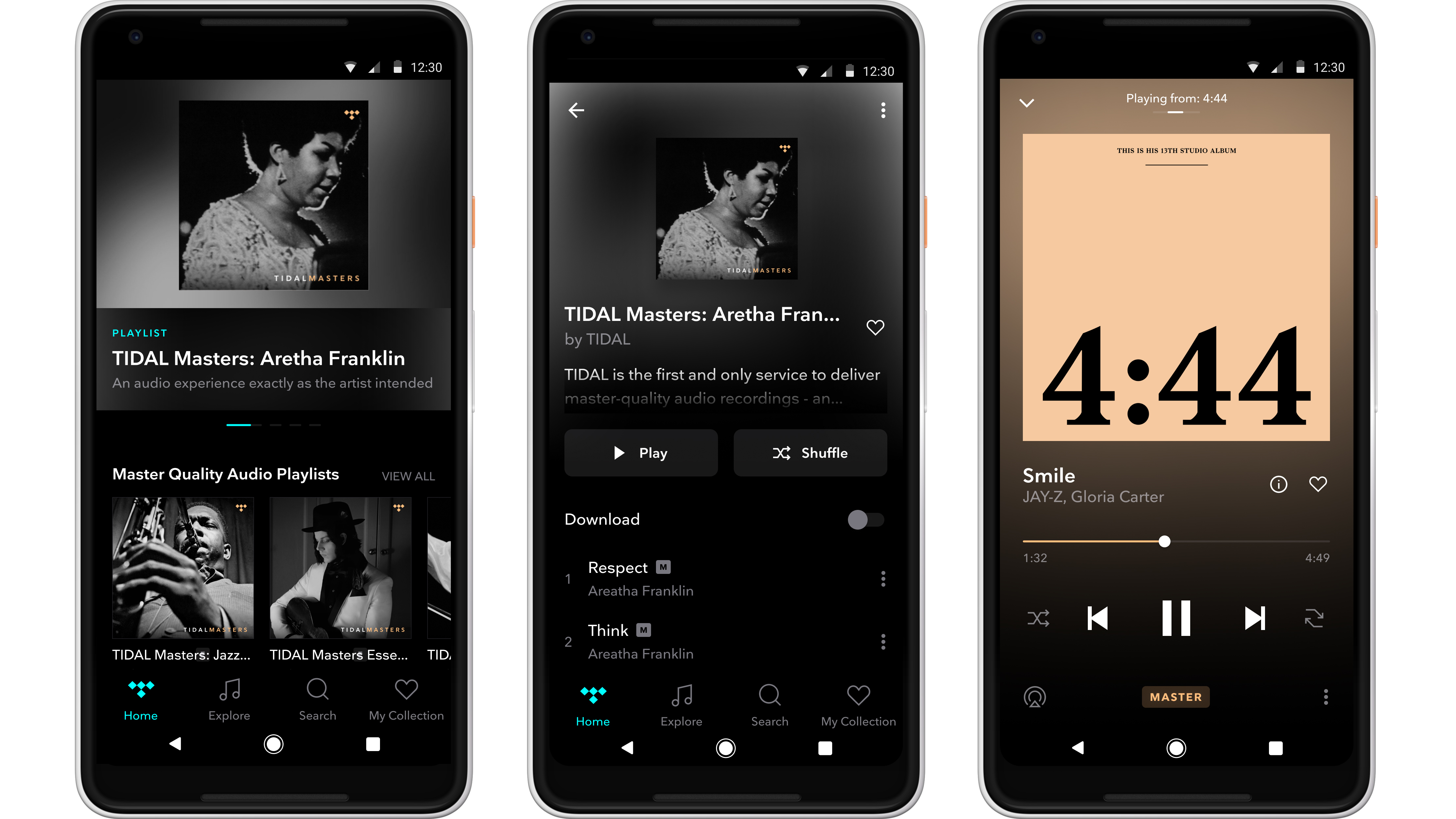
Tidal has been riding the hi-res wave since 2017 when it began offering hi-res audio streaming thanks to the adoption of MQA technology. It remains a solid hi-res proposition today, but plenty has changed in the past few years.
Firstly, MQA no longer powers Tidal's hi-res streams; FLAC does. That means its hi-res catalogue is no longer restricted to its mobile (iOS and Android) and desktop apps and MQA-supporting hi-fi equipment, as was the case for several years. As FLAC is an open-source format, any hi-res device can theoretically access the streams now.
The vast number of hi-res streams are typically 24-bit/96kHz, though 192kHz can also be found in the library. Dolby Atmos Music streams are also onboard for more immersive 'spatial' audio listening through headphones and, ideally, Atmos-compatible kit, from soundbars and TVs to AVRs and smart speakers. Tidal used to also play ball with Sony's conceptually similar 360 Reality Audio spatial format, but it ceased support for it in mid-2024.
Tidal Connect – a similar concept to Spotify Connect – also allows for easy hi-res streaming to compatible products from within the native Tidal app.
The excellent sound quality, intuitive interface and improving discovery and algorithm-driven playlist features make the Tidal app a popular one with audiophiles.
- Read our Tidal review
- Tidal tips: how to download music, play it offline, and more
Amazon Music Unlimited – value hi-res streams for Prime members
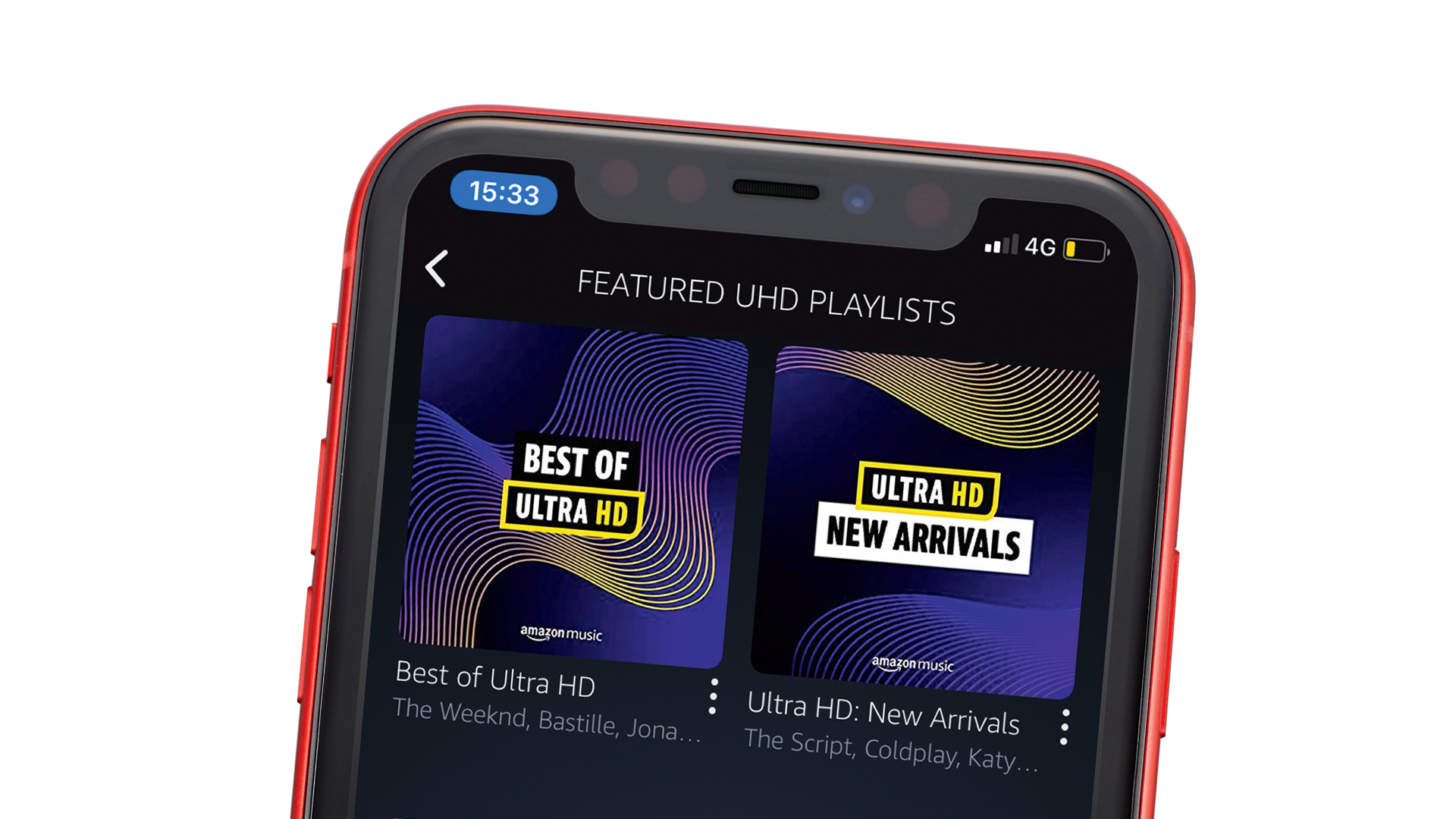
Whichever way you approach it, Amazon has gone super aggressive on pricing. In response to Apple Music's hi-res streaming announcement in 2021, Amazon made its hi-res Music HD tier (which was an additional £5 / $5 per month) free for Amazon Music Unlimited subscribers. Price-matching Apple Music, it is currently the joint-cheapest way to stream in hi-res – but Prime members get a discount on the subscription making it the most affordable hi-res option out there for them.
You can access Amazon Music Unlimited's 'HD' (16-bit CD quality) and 'UHD' (hi-res 24-bit) streams via three different avenues: the desktop app, the Android and iOS mobile apps, and compatible audio hardware with direct access to Amazon Music.
To Amazon’s credit, it pushes its seven-million-strong Ultra HD catalogue extremely hard on the service with dedicated playlists and clear labelling, e.g. Best of Ultra HD, Ultra HD: New Arrivals, Ultra HD Hip-Hop and Ultra HD Jazz. It doesn’t take long to find a steady stream of UHD music to listen to.
Subscribers can also access Amazon’s catalogue of 3D audio tracks, encoded in either Dolby Atmos or Sony 360 Reality Audio, through their headphones or Amazon Echo Studio speaker.
We don't find Amazon Music's interface or discovery features quite as compelling as those from Tidal and Apple Music, but otherwise it's a strong all-round and great-sounding offering, particularly for Amazon Prime subscribers.
- Read our Amazon Music Unlimited review
Qobuz – for audiophiles and/or avid downloaders
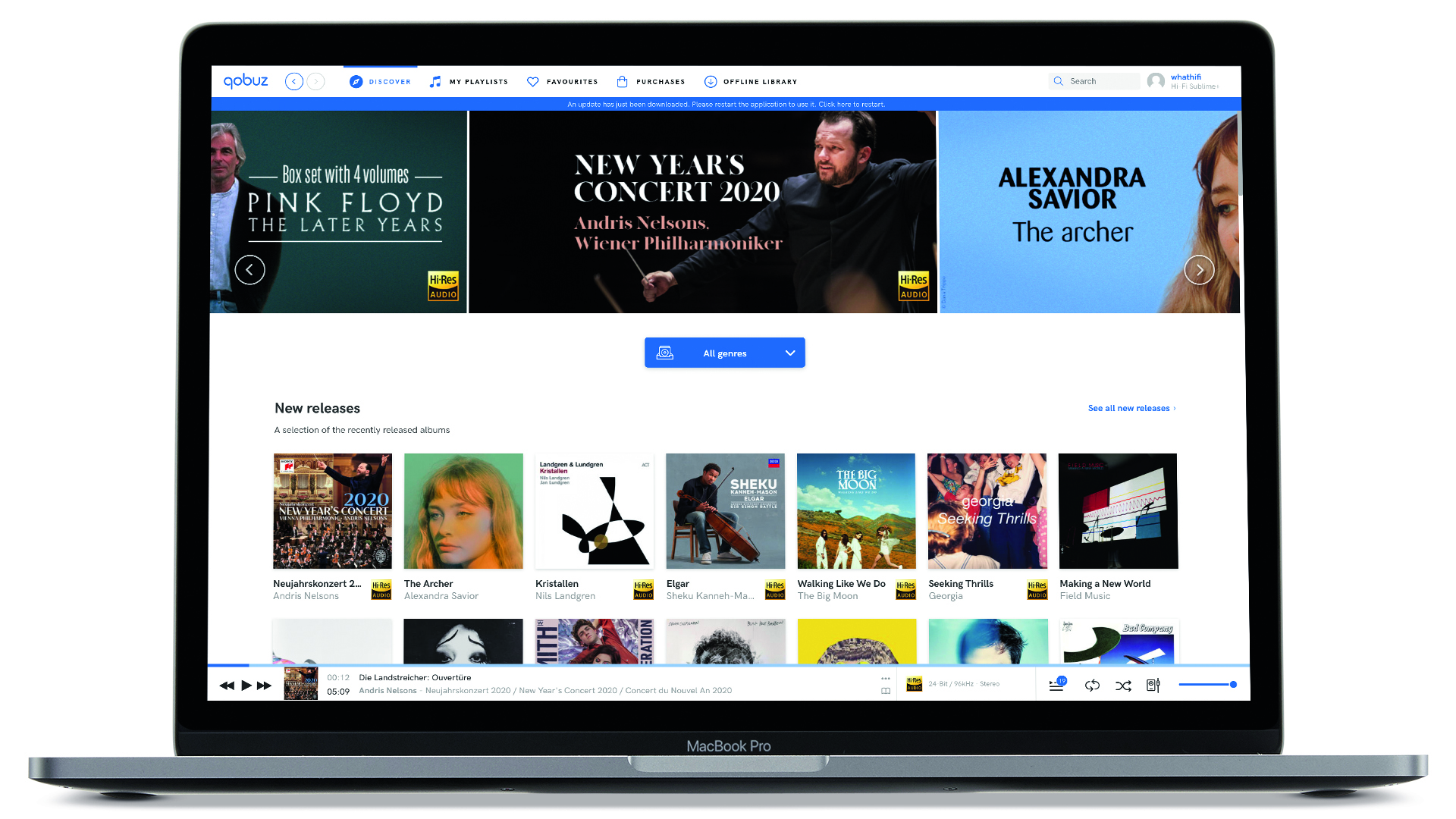
Qobuz's sound-first attitude has been clear from the very start. It was the first streaming giant to support hi-res, and also the first to drop MP3 streaming entirely, going all-in on CD quality and hi-res. In truth, taking a stand is nothing new to Qobuz, a company that tends to do things differently from most of its rivals in the music streaming world.
There are now just two packages from which users can choose: the Studio plan purely for CD-quality and hi-res streaming, and the Sublime plan which also throws in discounts of up to 60 per cent on purchases of hi-res 24-bit downloads.
The main sticking point for us at the beginning was the service’s high price and comparatively limited library, but the service's recent tier realignment and pricing, not to mention its work to bring its catalogue, user experience and device compataibility in line with the competition, has seen it rise pretty significantly in value. It is still slightly more expensive than the others, but it does feel like a compelling rival to Tidal now – not least for those who would take advantage of the discounted downloads. The long-awaited arrival of a Qobuz Connect cast feature would only pile on the attraction points, too.
It is a great-sounding service with a mature hi-res offering. Both Tidal and Qobuz offer free trials so, if you're torn between the two, you can try before you buy!
- Read our Qobuz review
Apple Music – for Apple device owners
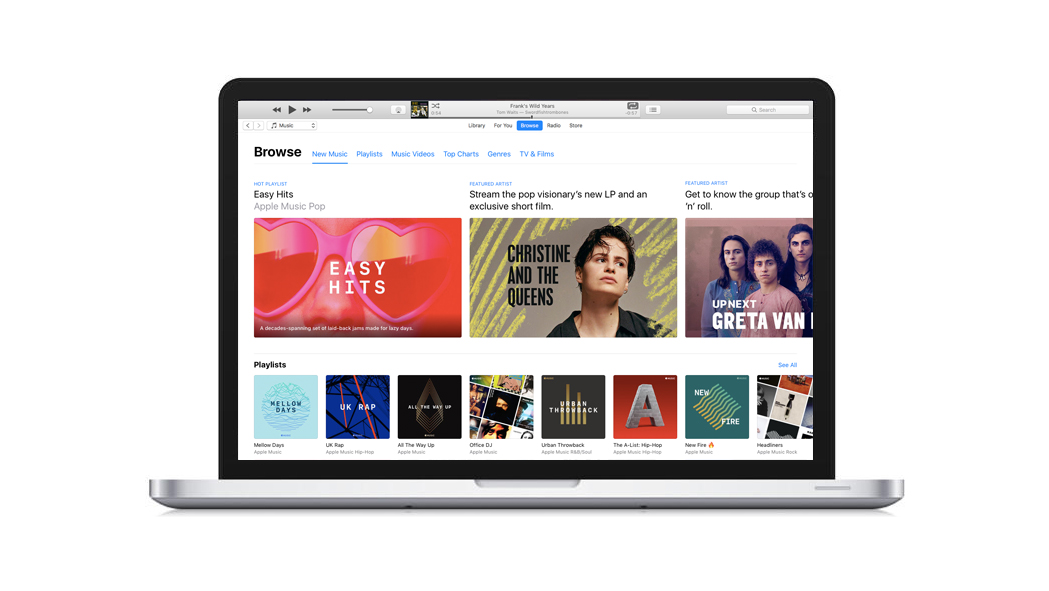
Apple offers CD-quality (16-bit/44.1kHz), Apple Music Lossless (24-bit/48kHz) and Hi-Res Lossless (up to 24-bit/192kHz) streams via its ALAC (Apple Lossless Audio Codec) codec. And the best bit? All of these streams are available under the standard subscription price. That puts it on a par with Amazon and Tidal. If you own an iPhone, the chances are pretty high that Apple Music is your service of choice – and its inclusive hi-res streaming only makes it harder to ignore.
Here's the rub, though: Apple's own headphones don't support lossless audio. None of them. Not even the AirPods Max over-ears wired. Apple's iPhones (since the iPhone 7) natively support lossless – but only Apple Music Lossless, not the highest quality Hi-Res Lossless. If you want to listen to Apple Music tracks above 24-bit/48kHz on your iPhone, you'll need to connect an external DAC and use a wired pair of headphones. Check out our guide for how to listen to hi-res audio on an iPhone. AirPlay 2 – the cast feature for Apple hadrware and software – doesn't usefully support hi-res either.
Apple's HomePod range of smart speakers do support lossless – that's the brand new HomePod 2, the first-gen HomePod (2018) and current HomePod Mini. It's worth noting that they only support Lossless up to 24-bit/48kHz – not Hi-Res Lossless. The same is true of the Apple TV and iPad families, which are listed as supporting Apple Lossless, with no mention of Hi-Res Lossless.
Like Amazon Music and Tidal, Apple Music also now has immersive 3D audio tracks – this time through Apple's proprietary Dolby Atmos-powered Spatial Audio format. These tracks will play on AirPods or Beats headphones with a W1 or H1 chip, as well as on HomePods and the iPhone 11 onwards and iPad Pro (but not iPad, iPad Mini or iPad Air). Playing from an Apple TV 4K into a Dolby Atmos soundbar or system will work too.
Apple Music is a no-brainer for iPhone and iPad users, albeit not the most recommendable service for Android users, despite there being an Android app.
- Read our Apple Music review
- Apple Music tips: how to listen offline, use Alexa, share your account and more
- Apple Music lossless: which devices will (and won't) play lossless and spatial
Music services that don't support hi-res
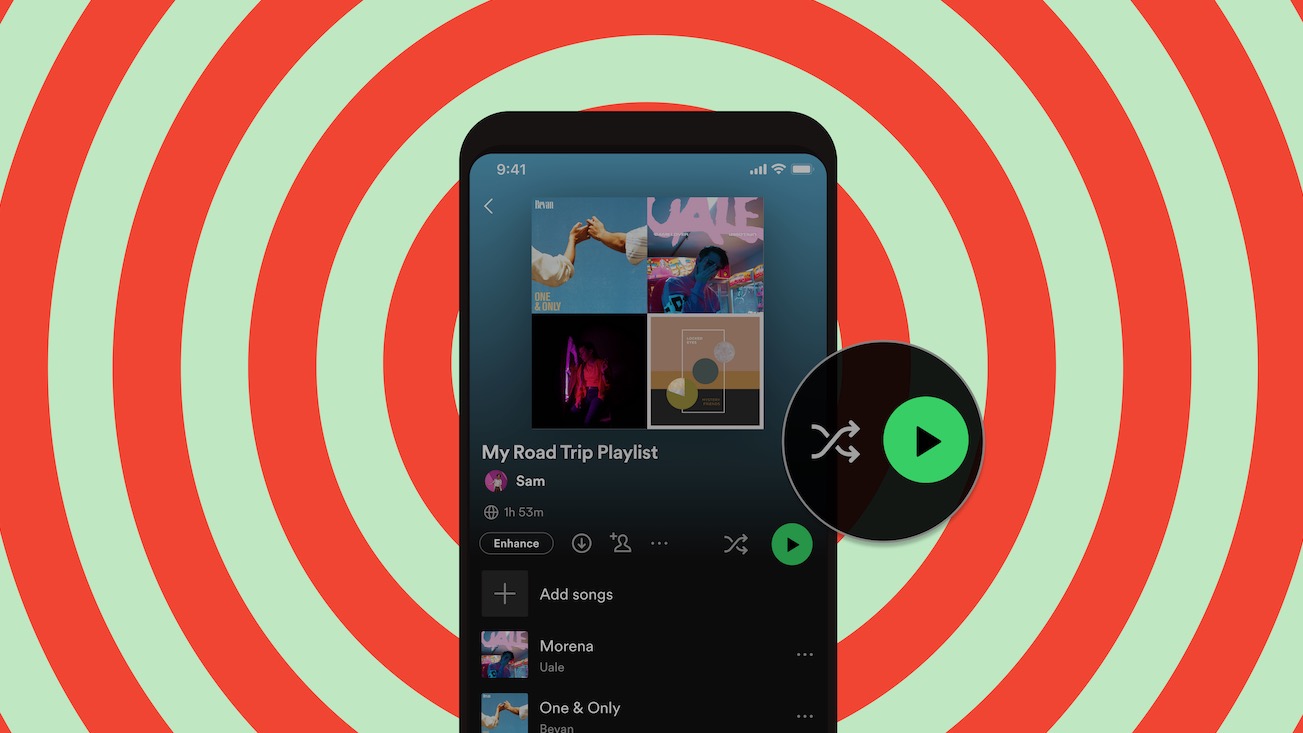
Another short answer: Deezer, Spotify and YouTube Music are yet to offer (or even promise to offer) hi-res audio.
Spotify still plans to launch its long-awaited and frustratingly delayed Spotify HiFi tier... at some point. It was promised by the end of 2021 but has still not yet materialised, and in July 2024 Spotify CEO Daniel Ek described a higher-quality Spotify as being "in early days". It remains to be seen whether hi-res quality will now be on the menu considering its adoption by Apple and Amazon since, or whether the service will stick to the CD-quality streaming it initially promised.
So will Deezer (which offers CD-quality) or YouTube Music (which maxes out at 256kbps) ever go hi-res? Alexander Holland, chief content and strategy officer at Deezer, offered some choice words on this in 2021: "Our goal is to make sure that Deezer brings value to both artists and music fans. We’re not ready to announce anything just yet but are considering the implications on our users, technology and business. It’s clear that our industry shifted overnight and HiFi is the new de facto standard for audio quality. We would never want to stand in the way of that. You’ll hear more from us soon."
But those considerations clearly haven't resulted in hi-res adoption in the past three or so years. There's nothing to report from YouTube on the hi-res matter either.
Verdict: which hi-res streaming service is best?
Ultimately, the delicate balance of budget and device compatibility within your home will determine which service you opt for.
Tidal is our current Award winner: the user experience is spot on, the catalogue is extensive, and the recent price lowering and introduction of Tidal Connect has helped its case even further.
Qobuz is a good shout for audiophiles now too, and uniquely offers Sublime subscribers heavily discounted downloads for those who like to stream and own digital music.
Amazon Music Unlimited has recently positioned itself as the joint-cheapest hi-res option (alongside Apple and Tidal), and the outright cheapest for Prime customers in the US and the UK, though its user experience is not quite up to scratch of its rivals in our minds.
Apple Music, however, is a no-brainer for owners of Apple devices who wish to enjoy hi-res streams, not least due to its competitve price, vast library and the added bonus of spatial audio. The downside, however, is that it isn't very hi-fi friendly (AirPlay doesn't support hi-res, after all) and you'll need a DAC to play maximum hi-res bitrates through your iPhone and wired headphones.
The hi-res streaming service landscape is more compelling and comparable than it's ever been. While Tidal and Amazon have historically had the edge where sound quality is concerned, now all four are more or less on the same playing field, with differences between their deliveries often being on a track-per-track basis.
But each give audiences a reason to pick them, and which you decide on will be down to your kit, preference and, to some extent, monthly budget.
MORE:
Got the service? Now read how to choose the right speakers and get the best sound
Struggling to hear the difference? The problem with hi-res audio is how you might be listening to it
Want to own your own music? How to build your own digital music library
Get the What Hi-Fi? Newsletter
The latest hi-fi, home cinema and tech news, reviews, buying advice and deals, direct to your inbox.
Becky is the managing editor of What Hi-Fi? and, since her recent move to Melbourne, also the editor of the brand's sister magazines Down Under – Australian Hi-Fi and Audio Esoterica. During her 11+ years in the hi-fi industry, she has reviewed all manner of audio gear, from budget amplifiers to high-end speakers, and particularly specialises in headphones and head-fi devices. In her spare time, Becky can often be found running, watching Liverpool FC and horror movies, and hunting for gluten-free cake.
-
James Robinson The issue that I have found is not with sound quality, but with the quantity of music of particular genres on offer (and how it is presented in searches), which is entirely missed in this comparative review.Reply
For classical (and, from what I have read, for jazz) Qobuz seems much better than any of the other options (although, to be fair, I have not tried Apple Music for a long time due to the lack of any hi-res files, which I understand is shortly to change). -
bristollinnet A stupidly timed article from What HiFi who just couldn't be patient until Apple's new service goes live. Future Media 'journalism' at its irresponsible worst.Reply
Anybody who signs up this week for anything is an idiot. -
dlundh Apples lossless and dolby atmos is live now though. The Dolby Atmos stuff is great through the ATV to my receiver. I may stop buying multi-channel SACDs now...Reply
Weird that MQA, a lossy compression, is touted as something to strive after though. -
djh1697 I have both Qobuz and Tidal, simply because they support Roon, which is an excellent interface!Reply -
DELBOY14 I have been using Amazon for a year now and at £8.00 as a Prime member I think it provides a service that's above average, what's not to like at £8. plus 24bit/192khz FLAC, nobody else gets near it and the full version is very easy to find what you want to listen to, you just use the search engine like any other programme.Reply -
davidc ReplyJames Robinson said:The issue that I have found is not with sound quality, but with the quantity of music of particular genres on offer (and how it is presented in searches), which is entirely missed in this comparative review.
For classical (and, from what I have read, for jazz) Qobuz seems much better than any of the other options (although, to be fair, I have not tried Apple Music for a long time due to the lack of any hi-res files, which I understand is shortly to change).
Not "entirely missed". Amazon pushes the Hi-Res stuff to you, and clearly labels every song. -
davidc ReplyIsinor said:I have been using Amazon (30 days free) compared to Tidal or Spotify it’s a complete disaster, the android app has so many frustrating usage issues, keep away is my recommendation. I’m happy to pay a little extra to get something that puts access to music as a priority. Maybe the lifetime membership of Roon is worth the cost.
I would agree that the Amazon app leaves a lot to be desired in terms of it's UI and ergonomics, but it is not a reason at all to stay away from it, unless you are the kind of person who can never figure out how to use your stereo/TV system because you have 2-3 remote controls. -
AEBWright Get Tidal subscription through the Plex platform. This is cheaper and allows search results which include streams and also your own downloaded library. The text and reviews are worth having too.Reply -
TheLastMan Reply
Spot on! As long as you get at least 320kb compressed 16/44 audio then the most important thing is the size of the catalogue of music, the user interface and range of equipment you can use it on. I use Spotify because the library is VAST, I can get it on my phone, laptop, Raspberry Pi LMS streamer and Sonos streamer - the interface is also good and very intuitive and I have a licence for all 5 of the family (including my ex wife!) for £17 . For classical music nothing beats Idagio! It is basically an archive of all the classical music ever recorded available in FLAC 16/44 quality on my phone and Sonos streamer. The interface could do with a bit of work but is great otherwise. I think lossless is much more important than high-res anyway.James Robinson said:The issue that I have found is not with sound quality, but with the quantity of music of particular genres on offer (and how it is presented in searches), which is entirely missed in this comparative review.
For classical (and, from what I have read, for jazz) Qobuz seems much better than any of the other options (although, to be fair, I have not tried Apple Music for a long time due to the lack of any hi-res files, which I understand is shortly to change).
I am hoping Spotify will go 16/44 lossless for their HiFi level. If they did I would snap it up in an instant. I have yet to be convinced by Hi-Res. I have a Chord Qutest DAC which is claimed to give you the benefits of Hi-Res without the file size and bandwidth issues. Have to say it sounds awesome! -
Mrmason62 if only humans could hear above 20khz.Reply
There are those who insist they can hear hires audio. Tell you what buy a dog whistle and blow it. What can you hear?
Dog whistles are around 23khz!!
The quality doesn't come from the sampling and bit rate. Quality is determined by the source.
For best SQ when streaming then rip your CD and vinyl collection.
The SQ is a different class to any streaming service. But only So long as youve got a good source.
Convenience comes at a very high price. That price is sound quality.
Thats too high for me

